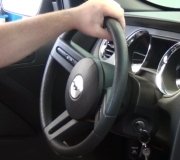This is very common on any vehicle. It's caused by a broken belt in one of the tires. A few tire brands are noted for this, and some others commonly develop broken belts right at about the time the tread is worn out and it's time to replace the tires.
The people at any tire and alignment shop can identify the defective tire and show it to you. The easiest to see is when there's what looks like a hump or tumor on one part of the tread as you rotate that tire. Often the tread will squirm sideways too as it is rotated.
The harder defect to find is when the belt breaks very gradually over many weeks or months. The hump develops real slowly, then the tread wears down in that spot, so it looks perfectly fine. You have to look at the deepest part of the grooves in the tread, then you'll see that part rises and falls a little as the tire is rotated. While the part of the tread that contacts the road surface looks okay, the break in the belt doesn't support the weight of the car as well, so that axle will drop a little each time that spot on the tire hits the road. Most people feel that as an out-of-balance problem, but the clue is it occurs at low speeds too where balance problems aren't felt.
When the broken belt is on a front tire, you'll see the steering wheel oscillate left and right a little, once for each wheel revolution, and you'll see it at real low speeds, such as when driving through a parking lot.
Sunday, July 21st, 2019 AT 5:41 PM


